Sharks in the Time of Saviors by Kawai Strong Washburn. 2020
I picked up an advanced reader’s copy a few months ago since it was about Hawaii, seemed right up my alley. A trip in early 2020 to Japan meant I was only reading books about Japan so it sat collecting dust on the bookshelf despite its great cover.
Well hello covid and I wanted to read some fiction and saw it was getting some nice press. I don’t often read new books since the wait list is usually long at the library so it seemed a treat to read something that was published in March.
The book is a magical realism-lite story about a family from the Big Island who have to move to Oahu to try to make ends meet. The story alternates by having each chapter from all the family members.
It starts off with the young couple having a little alone time in the Waipi’o Valley while a relative babysits their first son Dean. They have an encounter with the Night Marchers (ghosts of ancient Hawaiian warriors) and get the heck out of there. 9 months later their second son Nainoa is born. When he is 7 he falls overboard into the ocean and sharks save him. That is when the family starts to think there is something special about him.
This book did not go in the direction I thought it would. Having the chapters of the 3 siblings I found the most interesting. I really liked when the daughter Kaui would talk about hula and mention the moves since I actually knew what she was talking about.
The author also touched upon how hard this family has to struggle for money. Really hit home when I read an article today about how Hawaii is the most expensive state to live in and their unemployment rate is going up and up since tourism makes up so much of their economy. So not the most uplifting book but still engrossing and very Hawaiian.
BiblioTiki
Welcome to the Bibliotiki. Allow yourself to be transported to the islands by pulling a dusty old volume off the shelf, have a seat in one of our comfy rattan chairs and have the collections librarian/bartender, Alohatiki fix you a Singapore Sling, a zombie prince or perhaps a Bibliotiki, our signature drink (waiting for cataloging by the Library of Congress before we can release the recipe).
Monday, May 11, 2020
Friday, May 25, 2018
Tyree : Artist of the South Pacific by CJ Cook
Tyree : Artist of the South Pacific by CJ Cook. 2017
This gorgeous new book covers the life of artist Burke Tyree. I wasn’t familiar with the artist when I ordered the book but now I realize I have seen his paintings before especially when I went to Minne's in Modesto years ago.
What is wonderful about this book, are all the small pieces of history the author found about Tyree, not just his paintings but small things like a birthday card he illustrated for his wife or photos of a play plane he built for his kids on Guam.
It appears the author has been working on this project for years and was in close contact with the family, which really shines through in this book due to the items he was able to share.
Tyree had one of those lives that would make a great movie. Stowed away on a boat at a young age, met a beautiful girl who he would later marry (and have 7 kids!), lived in Guam, Hawaii and California. And painted gorgeous naked Polynesian women.
He had only heard of Leetag but by time Tyree got into painting on velvet, Leetag was dead. Tyree was painting on board previously and sold many of those worldwide. Then he moved onto velvet and his paintings look even more lush.
One thing I loved is that he made his frames himself and incorporated a notching technique that his kids helped with.
The book also includes the romance between him and his wife, we get to see letters he wrote during the war, many he illustrated.
It seems the whole family is artistic and the end of the book includes nice summaries on what they have done. I am sure he would be very proud.
After reading this book, I think I need to take another trip to Minnie’s!
Below are some scans from the book. They really don't do the book justice though, it is a very attractive and readable book. You can purchase the book here and even get it inscribed by the author. Also a congrats to the author for winning the two gold awards in 2017 from the Independent Book and Publishers Association (IBPA). The book won the Best Biography award & Best Cover award. That cover does make you want to do a face out display!
Wednesday, August 16, 2017
The Dance of Tahiti by Jane Freeman Moulin
July is one of my favorite months because it is Tahitian dance month. Well, at least it is in Tahiti where the annual Heive I Tahiti takes place. Kinda of the Olympics of Tahitian dance. Over the years I would try to figure out how I can watch as much of it online as possible. Things have gotten easier with youtube and now I follow a French Polynesian tv station on Instagram so I got to see clips all month.
My love of Tahitian dance was like all the things Polynesian that I am interested in, slow and evolving over the years. According to family lore, we went to Disneyworld when I was young (5?) and they said I could pick anything at the gift shop. I had a deep love of mice so they figured I would pick something Mickey. Well I picked a hula doll. I have no idea why. I was not the type of girl who ever, every wanted to play with dolls (except Barbie). I still recall what she looked like and seeing her at the store but then I no memory of ever seeing it again. Did my family go back and exchange it? I have no clue.
Then we had a trip to Oahu and Maui when I was in like 6th grade to slowly stoke the fires. But more recent (well 2002) they were offering Tahitian dance at my YMCA on Friday nights. I went and it was great. My teacher I later realized actually had her own Tahitian dance group and was kinda using the Y as a paid practice space. She even brought in live drummers. I loved the music and the drumming. I wasn't very good but didn't care. She later told me about the annual Tahitian Dance festival in San Jose, the Tahiti Fete. My husband and I went every 4th of July holiday since I think 2003 for years. Then they sometimes moved it to Hilo and we fell of going. I went this year and got to see...the Tahitian Dance group who I use to be in perform at the Fete.
Sadly, my YMCA class ended and I was left without a class for a few years. Then one night while walking to get some food I heard the sound of the pahu (sharkskin drum) coming from a Russian Ballet studio. I peered thru the blinds and saw a bunch of girls in pareaus Tahitian dancing. It took me a few more months to figure out who this group was and then I emailed them and asked if I could join and told them of my "experience". They let me in and I had much to learn. We did 1 hour of hula and 1 hour of ori and aparima (both Tahitian dancing). I stayed with them for 3 years and even performed twice on stage at the Palace of Fine Arts. I made some friends and learned a lot. I then had to leave the group because I switched jobs and can't make it to their Wednesday night practices anymore. I still go to their events and was thrilled to see them at the San Jose Fete.
But this is suppose to be a book review so let me get back to that. When I started collecting for the Bibliotiki I always had a focus on Tahiti but I never could find books about Tahitian Dance. I did eventually find this book online for like a $100. I am cheap so that wasn't going to happen. Then years ago we went to a musty bookstore on Oahu and I saw it behind the counter for $20. What a steal! To my knowledge there isn't really any other definitive book on the topic. The book was published in 1979 and the author started her research there in 1973 and stayed for 3 1/2 years. She wound up dancing with many of the groups and formed a touring group.
Despite owning this book for like 6 years I didn't read it until now. Kinda wish I read it when I was in my dance group. It shed a lot of light on why we were doing certain things and terminology used.
She covers the history of Tahitian Dance (which is actually called Ori Tahiti my kumu would like you to know), breaks down the dance types, instruments and costumes. By the early 1820's the Church was outlawing traditional dance. It would continue in secret (just like the Hula). But in the 1950's Madeleine Mou'a formed the first professional dance group on the islands. It took some time but it finally regained its place in the culture.
The costume chapter was interesting especially since I got to make a little of my costume when I was in my dance show. Nothing like the photo below, more just braiding leaves. These skirts are called more and are natural fibers and dyed with natural dyes.
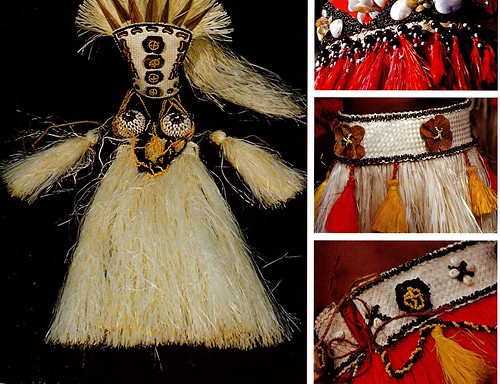
She talks about all the rules surrounding the annual Heiva I Tahiti competition. No man made materials allowed, dancers have to dance entering and exiting the stage, the size of the group and etc.
She does seem saddened by how the dance has changed a bit to accommodate hotel shows. But overall I think the book holds it own in 2017.
She even has diagrams of the movements for men and women.
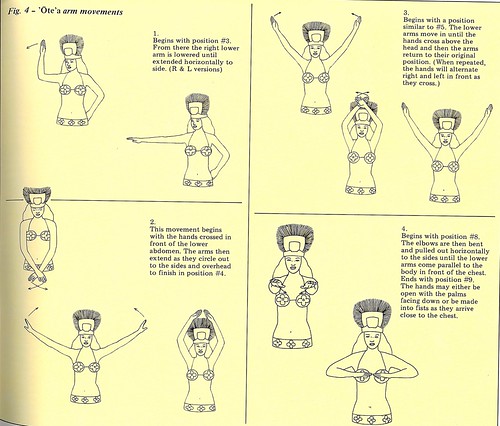
And it has a lot of nice group shots.
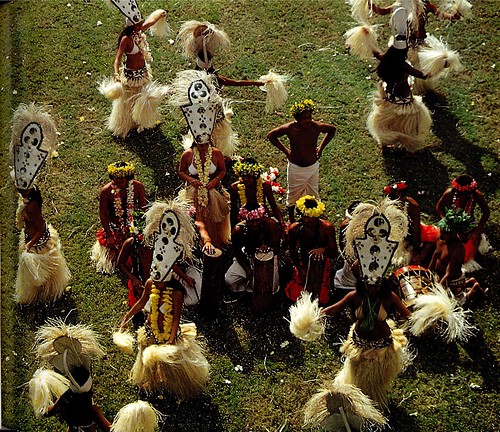
Sometimes these groups can have around 70 dancers and it is totally choreographed.
The book also helped me understand my South Pacific record collection (over on the Phonotiki) better. I also focus on music from Tahiti and now I realize I have many albums from many of the mover and shakers of the late 1960's-1970's who were keeping the dance alive (Coco!). I also learned a little more terminology of certain dance styles that are on the Lps.
Have a look at some videos here and Full Videos here.
And if you want to find out where you can see and learn Tahitian Dance click here.
Dr. Jane Freeman Moulin is a Professor of Music at the University of Hawaii at Manoa and is currently working on a book about Tahitian music.
Thursday, June 22, 2017
Savages by Shirley Conran
Savages by Shirley Conran. 1987
It was a good day at the thrift store up north. My husband and I went on a mini vacation and while on our way home went to a Goodwill. I had walked in and commented that I hope I find a tiki mug. In the next 30 seconds my husband plucks a vintage pineapple mug that still had the top attached off the shelf. Well that was easy. I look around and see some book called Savages. I always look at books that sounds jungle-like just in case the South Pacific is hiding inside. I open it up to a map of Papua New Guinea and think that I am on the right track.
I see on the cover it says it is by the author of Lace. I recall nothing about it except it is was a mini series with Phoebe Cates and was suppose to be a bit salacious. For $2.49 I figure I can gamble on it.
This book is about a group of women who have to go on a business trip with their husbands to Australia, PNG and the fictional island off of PNG called Paui. There is a lot of backstory on these women and their family life. I kept getting them confused and no one has much of a personality.
Eventually they make it to Paui and do to some shady business dealings most of the men are killed when the women are off on a 3 hour tour. The women return in time to see their husbands killed and a military coup in action. They leave with the captain of their ship and try to survive in Paui until they can figure out how to get back to civilation.
Lucky for them their captain is a great survivalist and teaches them many lessons before of course he dies.
As one would suspect, there is some light sexual action since this is the author of Lace. The ending is a bit grim and not really the direction I thought the book was going.
Overall it wasn't a bad read and you could tell it was well researched. I might of learned a survival skill or two. I think it was suppose to be a mini series as well but I can't find any evidence that they filmed it.
In case you were wondering where Paui is.
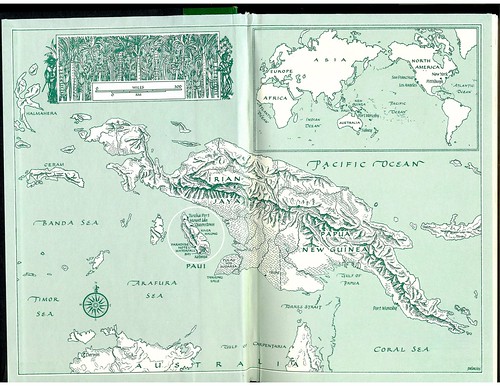
I liked the illustrations for each part of the book.
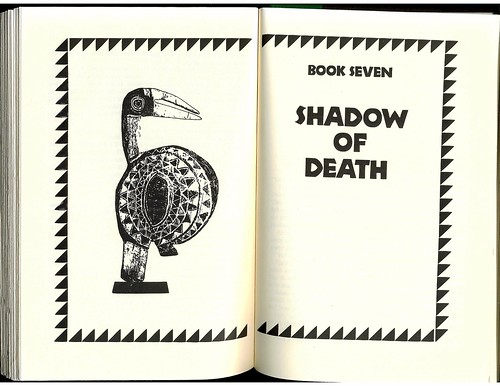
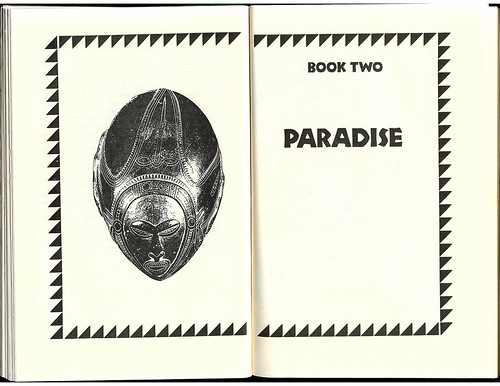
Lastly, here is a nice article about the author who they call Queen of the Bonkbuster.
It was a good day at the thrift store up north. My husband and I went on a mini vacation and while on our way home went to a Goodwill. I had walked in and commented that I hope I find a tiki mug. In the next 30 seconds my husband plucks a vintage pineapple mug that still had the top attached off the shelf. Well that was easy. I look around and see some book called Savages. I always look at books that sounds jungle-like just in case the South Pacific is hiding inside. I open it up to a map of Papua New Guinea and think that I am on the right track.
I see on the cover it says it is by the author of Lace. I recall nothing about it except it is was a mini series with Phoebe Cates and was suppose to be a bit salacious. For $2.49 I figure I can gamble on it.
This book is about a group of women who have to go on a business trip with their husbands to Australia, PNG and the fictional island off of PNG called Paui. There is a lot of backstory on these women and their family life. I kept getting them confused and no one has much of a personality.
Eventually they make it to Paui and do to some shady business dealings most of the men are killed when the women are off on a 3 hour tour. The women return in time to see their husbands killed and a military coup in action. They leave with the captain of their ship and try to survive in Paui until they can figure out how to get back to civilation.
Lucky for them their captain is a great survivalist and teaches them many lessons before of course he dies.
As one would suspect, there is some light sexual action since this is the author of Lace. The ending is a bit grim and not really the direction I thought the book was going.
Overall it wasn't a bad read and you could tell it was well researched. I might of learned a survival skill or two. I think it was suppose to be a mini series as well but I can't find any evidence that they filmed it.
In case you were wondering where Paui is.

I liked the illustrations for each part of the book.


Lastly, here is a nice article about the author who they call Queen of the Bonkbuster.
Sunday, August 28, 2016
Tahitian-English Dictionary
Tahitian- English / English-Tahitian Dictionary published by Leonard Clairmont.
I had been looking for an Tahitian Dictionary for a few years and this one just fell into my lap. A friend who I buy many of my Polynesian records from just gave it to me, but he was unaware of my quest for it.
This is a very slim volume and by no means comprehensive. I assume it was aimed at the tourist to Tahiti in the 1960's but probably not super useful.
The table of contents covers the basics
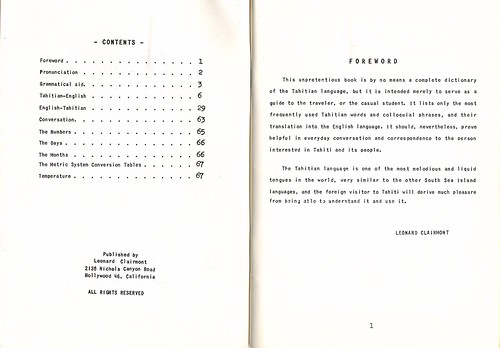
It does have some nice photos though
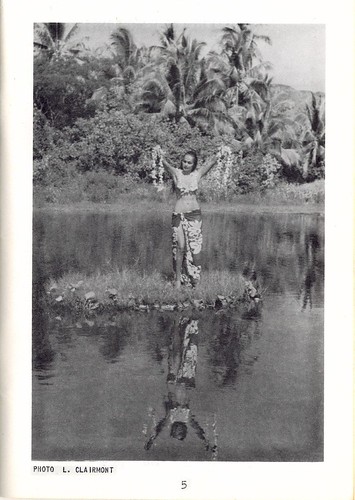
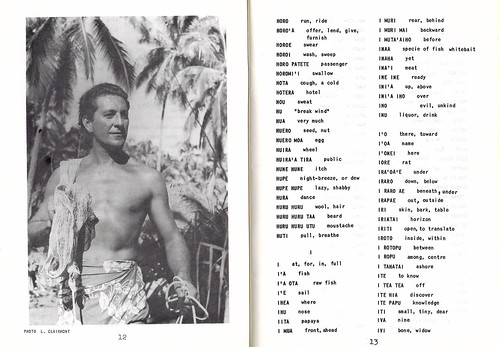
And does include some phrases you might need.
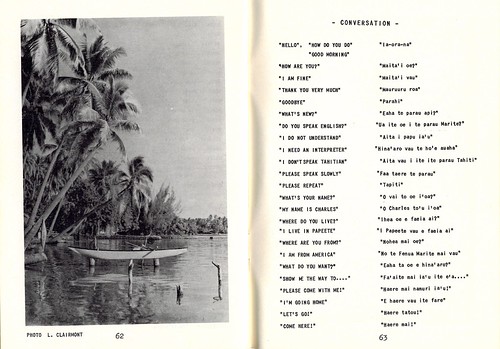
And now I can say toilet in Tahitian! Fare iti
I had been looking for an Tahitian Dictionary for a few years and this one just fell into my lap. A friend who I buy many of my Polynesian records from just gave it to me, but he was unaware of my quest for it.
This is a very slim volume and by no means comprehensive. I assume it was aimed at the tourist to Tahiti in the 1960's but probably not super useful.
The table of contents covers the basics

It does have some nice photos though


And does include some phrases you might need.

And now I can say toilet in Tahitian! Fare iti
Monday, July 4, 2016
Secrets of Diamond Head by Denby Fawcett
Secrets of Diamond Head by Denby Fawcett. 2015
Diamond Head, what could be a more iconic representation of Hawaii? If you go to Oahu you fly over it, you can see it from anywhere on Waikiki Beach and cheesy books have been written about it.
Though the Secrets of Diamond Head by no means is a cheesy book. It is actually pretty wonderful if you want to know the history and see some really great historical images of Diamond Head through advertising and photos.
In addition, it contains a trail guide that is annotated, how the crater was created and history of Hawaiian and the military presence on Diamond Head. The chapter I found most interesting was about saving Diamond Head. It is a miracle that there isn't a luxury hotel or a condo on the slopes of Diamond Head but that is due to the energy many have fought to make sure that doesn't happen.
If you have never hiked Diamond Head here are a few tips:
You can pick up this book thru the University Of Hawaii Press site.
July 2015, sitting on the balcony of my hotel, getting ready to read this classic.
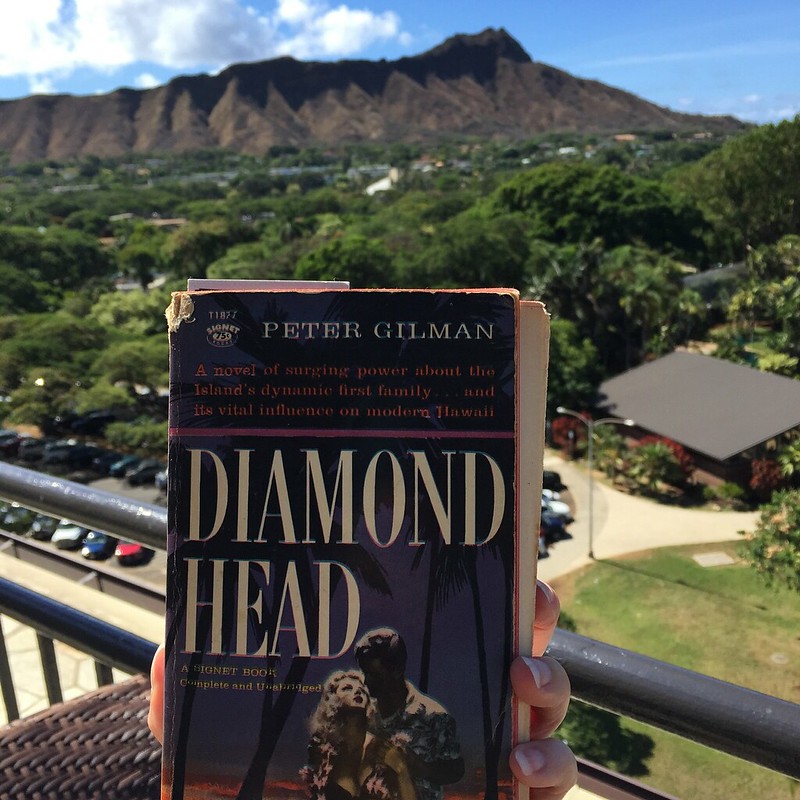
View from Diamond Head
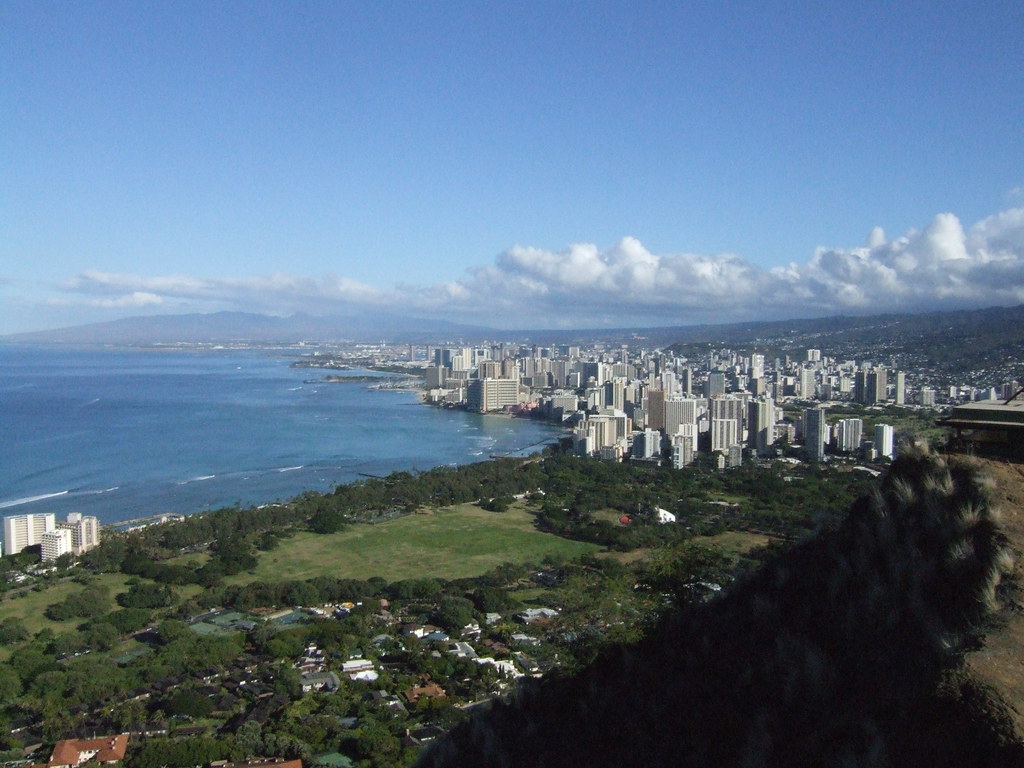
Diamond Head, what could be a more iconic representation of Hawaii? If you go to Oahu you fly over it, you can see it from anywhere on Waikiki Beach and cheesy books have been written about it.
Though the Secrets of Diamond Head by no means is a cheesy book. It is actually pretty wonderful if you want to know the history and see some really great historical images of Diamond Head through advertising and photos.
In addition, it contains a trail guide that is annotated, how the crater was created and history of Hawaiian and the military presence on Diamond Head. The chapter I found most interesting was about saving Diamond Head. It is a miracle that there isn't a luxury hotel or a condo on the slopes of Diamond Head but that is due to the energy many have fought to make sure that doesn't happen.
If you have never hiked Diamond Head here are a few tips:
- Get there early! Like 7am early or else it is too crowded and too hot
- Bring water
- Wear comfy shoes and clothes
- If you go on a Saturday, visit the nearby KCC farmers market. So much good food and drink there.
You can pick up this book thru the University Of Hawaii Press site.
July 2015, sitting on the balcony of my hotel, getting ready to read this classic.

View from Diamond Head

Friday, August 21, 2015
White Savages in the South Seas by Mel Kernahan
In my readings over the last few years about the South Pacific, I kept seeing references to this book. Some were dismissive of it and after reading it I can only surmise they don't like their idyllic view of islanders busted.
I greatly enjoyed this book. And since I like to focus on woman writes of South Pacific literature I found Mel to be quite the character. The first paragraph on the back of this book pretty much sums it up:
White Savages in the South Seas is a book about Polynesia after the cruise ship has sailed, the jet has flown off into the sunset and the maitai curtain has dropped on a dream that was more performance than reality.She has been visiting Polynesia since her first trip in 1959 and the book covers to 1992, which is a pivotal time period of change in that region due to the impact from the west. Before you had easier air travel, the amount of visitors wasn't so great. But then it all changed...
She starts off in Tahiti, going to the very first strip show in 1966. Apparently it was not a success. You might think the book will just be a laugh but she quickly moves on to politics and nuclear testing that the French did in the islands. She does then lighten it up a bit with a story about Susy No Pants and dancing at the infamous Quinn's bar in Tahiti. I am always curious to hear about Quinn's since it is mentioned in many books and I have some LP's that were recorded there. It sounds like a total dive and kinda wonderful.
The middle of the book contains a depressing story of when Mel is back in California and stumbles upon a local spot visited by Tahitians who have moved here. Including one young girl whose island was pretty much destroyed by the nuclear testing by the French and her misery of having no home.
I was enjoying the book and then it really gripped me once she got the Cook Islands. I went to the Cook Islands on my honeymoon many years ago and always have an interested in them. Even though she was writing about the Cooks about 10 years before I went there, it brought back a lot of memories of what the islands were like especially with her part about staying on Aitutaki.
She has a chapter where she takes her dream boat ride on a cargo ship to another island. And then is sick as a dog due to a massive storm and seasickness. It is called "Damn you Robert Dean Frisbie". RDF is a legend in Polynesian literature which includes the infamous story of him tying his children to a coconut tree in a hurricane on an island in the Cooks. I too have a dream of taking a cargo ship to around to the island but now realize I would probably wind up like her, heaving over the side of the boat.
I will leave you with a quote from the book that really rang true for me and also would for those who love the "paradise" version of the South Pacific but know it isn't real.
'Damn you, Robert Dean Frisbie', I say aloud, ' and all the rest of your motley crew of misfit dream spinners, including you, James Norman Hall and Charles Nordhoff; Beatrice Grimshaw and Frederick O'Brien; damn you Robert Louis Stevenson and W. Somerset Maugham - I wish I loved you less'...
'Damn you for making such a glory out of unrequited love. Damn your loneliness, damn your pain. Damn your longing, damn your books, your words, your sirens' words - which can be the only mates of people like us who yearn to belong to an image of the South Seas...'
Subscribe to:
Comments (Atom)










